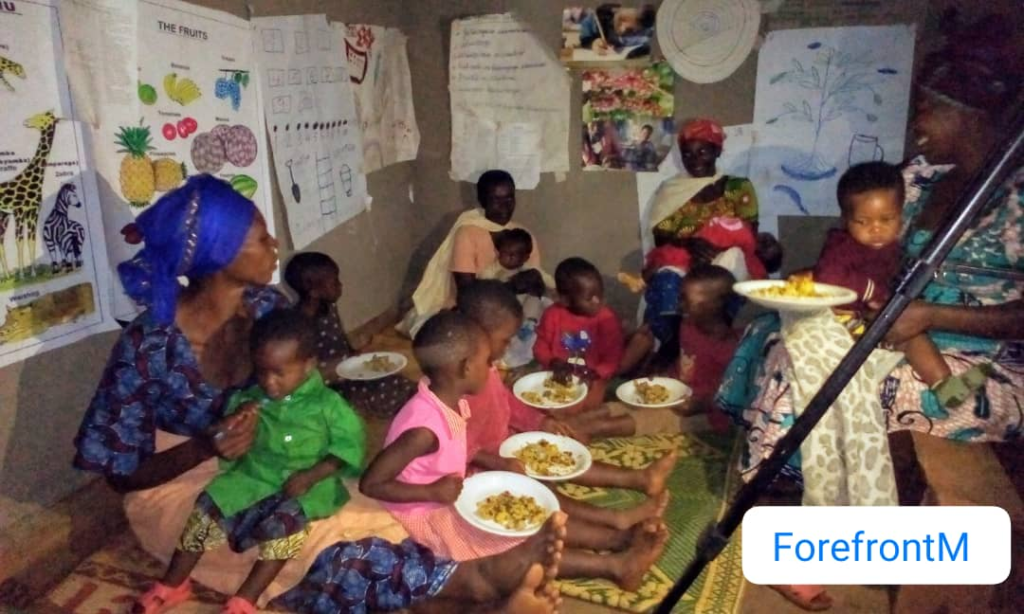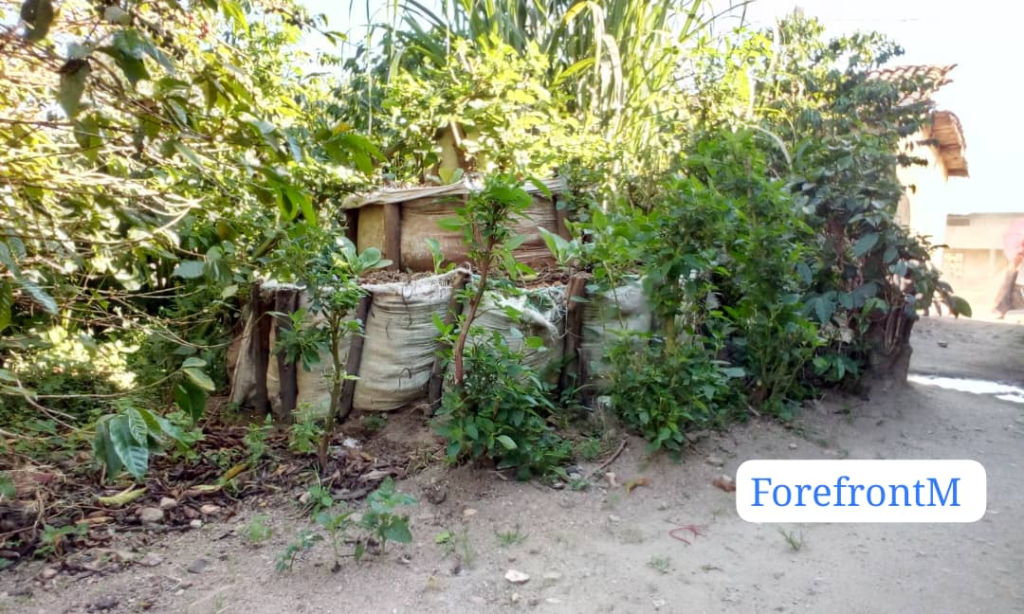By Annonciata Byukusenge
Marcella Nyiransabimana wakes up at five every morning. Her primary activities are farming on a small two-hectare plot of her farm in Mwurire and caring for her children in a remote Mwurire village in the Huye district of southern Rwanda.
At 40, Marcella Nyiransabimana, a mother of four, is a testament to the transformative power of individual dedication.
Her journey from a farmer in a remote Mwurire village to a beacon of hope for eradicating malnutrition in her community began in March 2012, when she completed training on the Village Kitchen initiative, a program supported by government stakeholders like UNICEF, World Vision, and others.
During the training, Marcella and others learned how to prepare nutritious food, use home-grown plants to feed their children and prioritize quality over quantity.
This emphasis on education is a crucial tool in the fight against malnutrition, empowering individuals with the knowledge they need to make a difference.

The kitchen gardens in Rwanda, typically measuring 2×1 meters but extendable based on available land, symbolize hope for a healthier future. Constructing a kitchen garden takes about six hours and is often done for vulnerable families through community work, locally known as Umuganda. For others, the cost is $10.
Beyond the immediate benefits, these gardens, which are renewable after one year, promise a sustainable solution to malnutrition in the long run, instilling a sense of optimism and encouragement in the community.
While no specific vegetables are recommended, the villagers often plant short-term crops like beets, carrots, leafy greens, indigenous vegetables, and eggplants.
Depending on the animals they raise, these gardens use natural fertilizers from domestic animals such as cows, chickens, goats, and pigs.
In various villages, people typically make seed beds and share them with their neighbors for free, fostering a sense of community and shared responsibility in the fight against malnutrition.
The Problem of Malnutrition
Persistent hunger plagued Mwurire years ago, challenging daily tasks and school attendance by children.
According to the WHO, malnutrition leads to chronic tiredness, weakness, and reduced physical and mental stamina, severely affecting a person’s quality of life.
For children, it results in stunted physical and cognitive development, frequent illnesses, and social stigma, which further isolates affected individuals from community activities.
Statistics paint a grim picture of the malnutrition crisis in Rwanda and the broader Eastern Africa region.
The WHO says that nearly half of all child deaths under five are linked to undernutrition. In 2020, Rwanda reported a stunting rate of 33%, a slight improvement from 38% in 2015 but still alarmingly high.
According to a study on the prediction of stunting among under in Rwanda using machine learning techniques, of the 3814 children aged 0-59 months observed, 33.3% were stunted, with the highest prevalence being among children aged 24-35 months at 41%.
“I spend at least two hours preparing breakfast for my children every morning to ensure it is complete and includes vegetables, products from animals like egg or small fish, and products from crops like rice, potatoes, cassava, maize pasta, which are energizing body-building, and disease-preventing,” Marcella explains.
Her commitment is a direct response to the widespread malnutrition affecting children nationwide.
Malnutrition Globally

Status of Malnutrition in Southern Province by district


The Village Kitchen Initiative
Village Kitchen Initiative, locally known as Igikoni cy’Umudugudu, started in 2012 and has since expanded to various villages across Rwanda.
The government of Rwanda launched a program to combat malnutrition in rural communities by teaching parents. The parents meet twice monthly to be trained by community health workers to prepare nutritious food for two days.
Healthy meals contain a variety of foods, such as beans, potatoes, rice, bananas, small fish, eggs, maize, calotte, fruits, and other vegetables. This is for one meal. Rwanda has 14837 villages. Since 2012, kitchen villages have been introduced in each town, but kitchen villages located in rural areas are more active than in cities.

The initiative was introduced in response to the persistent malnutrition crisis, which standard kitchen gardens alone could not solve due to a lack of knowledge about preparing nutritious meals. The standard garden provided vegetables to the families.
Even if they had them, they didn’t know how to prepare nutritious food from the products they had at home. This initiative helped the community become skilled in preparing nutritious food based on the gardens they had near their homes.
The initiative involves a rigorous process of selecting and training community health workers. These individuals, often respected members of their communities, are taught by the Ministry of Health through the Rwanda Biomedical Center (RBC) to facilitate cooking demonstrations and best practices.

They visit homes, particularly those with children under five, to teach parents how to prepare balanced meals containing fruits, protein food like eggs, small fish, and milk using locally available ingredients like beans, bananas, sweet potatoes, potatoes, and sorghum, which are the most common foods.
This hands-on approach ensures that families understand the importance of nutrition and can apply these lessons in their daily lives.
“I spend at least two hours preparing breakfast for my children every morning to ensure it is complete, energizing, body-building, and disease-preventing; this breakfast contains eggs, small fish, banana, or potatoes, depending on the availability of food, beans, and only sorghum flour, a mixture of different grains or milk,” Marcella explains.
Her commitment directly responds to the widespread malnutrition affecting children nationwide and the lessons learned from the initiative.

The initiative is active in all 30 Rwandan districts, including the Huye district, with Mwurire village as a key beneficiary. Many years ago, Huye district was most affected by malnutrition. In 2017, Mwurire village had more than 40 children suffering from malnutrition, as Alex Habyarimana, a Community health worker from 2007, said.
He added that the “Village Kitchen” was officially launched in 2012 at the country level in the Huye district in the Kigoma sector, where 13 out of 147 children suffered from malnutrition.
Significant improvements
Residents of Mbazi in the Huye district have seen significant improvements in their children’s health since participating in the initiative.
One such resident, Antoinette Dusabimana, recalls how her child, who weighed only two kilograms at age two, now leads a healthy life after joining the Village Kitchen. “Before, I fed my child a poor diet, unaware of the nutrients vegetables provided,” she admits. She cooked beans and potatoes or rice from Monday to Sunday, depending on what he found nearby. He teased it all the time without thinking about the kids. Although potatoes, bananas, eggs, vegetables, and fruits were for sale. They did not eat them at home.
Now, Antoinette ensures her child receives balanced meals containing eggs, small fish, bananas, fruits, pasta, sweet potatoes, and potatoes, which resulted in a remarkable weight gain of 8 kilograms.
“I mix beans, sweet potatoes, small fish or eggs depending on the availability of each one, green vegetable or calotte,” Antoinette added. Rwanda has made notable progress in reducing malnutrition. Between 2015 and 2020, chronic malnutrition rates among children under five, known as stunting, decreased from 38% to 33%.

This success is attributed to initiatives like the Village Kitchen, emphasizing education and community involvement.
A study by the National Library of Medicine, enrolling 3814 children aged 0-59 months, found that 33.35% were stunted, highlighting the critical need for interventions.
The Village Kitchen has not only reduced malnutrition but has also fostered community solidarity. This initiative is the idea of President Paul Kagame, and he is investing in it.
Malnutrition reduced from 2015 to 2020 / DHS 2005- 2015 and 2016-2020

Neighbours of Mwurire village have adopted a similar model, creating a ripple effect across the region. This grassroots initiative exemplifies the power of community-driven solutions to address complex health challenges.

Community health worker Alex Habyarimana adds, “The impact we have seen through the Village Kitchen is profound.
We started with a small group of 47 households that had children suffering from malnutrition because people didn’t understand how it would help them at first. Participating in this initiative is free because it aims to empower the community.
The Taba and Bumbogo Villages joined. Now, the entire community understands the importance of proper nutrition because the 13 villages in Mwurire cell joined this initiative.”
Huye District collaborates with stakeholders to ensure food security for malnourished children.
For instance, UNICEF provides technical and financial support to provide essential kitchen materials like Washbasins, teaspoons, forks, aprons, jugs, cups, saucepans, plates, and food supplies, ensuring the sustainability of the Village Kitchen initiative.
The other stakeholders supporting the Kitchen Village Initiative are Trócaire, SOS Children Village Rwanda, Partner in Health (Inshuti mu Buzima), and the Ministry of Health.
Now, people are responsible for continuing this program even if the donors could stop granting them because most of the food they use in Kitchen Village comes from their families. They are knowledgeable about preparing nutritious food for their kids.
Samson Desie, UNICEF Rwanda Nutritionist, confirms the program’s effectiveness: “Malnutrition occurs when a person’s diet lacks sufficient nutrients. Training communities to develop kitchen gardens and teaching them how to prepare nutritious meals are essential to combating Malnutrition.”
The other partners in this initiative are the Government of Rwanda, President Paul Kagame himself, the World Bank, World Vision, Gikuriro NGO, Rwanda Biomedical Center (RBC), the Ministry of Gender and Family Promotion (MIGEPROF), Imbuto Foundation, and the National Child Development Agency (NCDA).
The Village Kitchen initiative is more than a response to malnutrition; it demonstrates the Rwandan people’s resilience and resourcefulness. According to the sixth Rwanda Demographic and Health Survey (RDHS2020), the rate of child stunting at the national level reduced from 38 percent in 2015 to 33 percent in 2020. The government targets to reach 19 percent in 2024.
The initiative has transformed lives and communities through education, community engagement, and the support of health workers and local leaders. It offers a model for tackling malnutrition worldwide. Now, 508 Kitchen Villages were established in Huye, and 14837 in the whole country because each village adopted this initiative.

Gaps in Engagement
Despite its successes, the initiative faces challenges. Initially, behavior change was slow, particularly among wealthy families who believed malnutrition only affected the poor.
Affluent families were also less accessible for community health workers, leading to gaps in engagement, as Alex Habyarimana, the Community health worker, highlights: “We had difficulty convincing wealthy families to participate because they were often busy and did not see the need for community health advice.”
Beneficiaries like Antoinette Dusabimana were skeptical and resistant at the beginning. “At first, I was unaware that vegetables are rich in nutrients that improve a child’s growth. It took time for me to change my feeding habits,” she recalls.
Marcella says, “I have learned much from cooking demonstrations. My child’s health has significantly improved, and I will continue to ensure he grows healthy and strong.”
